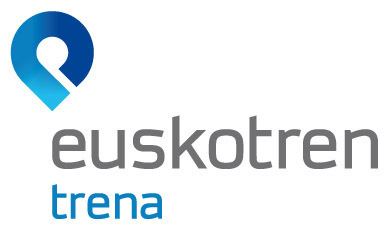Website Eskotren Trena Operator(s) Eusko Trenbideak Headquarters Bilbao Number of lines 8 | Began operation 1982 System length 181.1 km (112.5 mi) Number of stations 79 | |
 | ||
Track gauge 1,000 mm (3 ft 3 ⁄8 in) Owner Eusko Trenbideak – Ferrocarriles Vascos Transit types Commuter rail, Inter-city rail | ||
Euskotren Trena, formerly known just as Euskotren is a commuter, inter-city and urban transit train operating company that operates local and inter-city passenger services in the provinces of Biscay and Gipuzkoa, in the Basque Country, Spain. It is one of the four commercial brands under which Basque Railways operates, as a public company managed by the Basque Government. The entire 181.1-kilometre (112.5 mi) network uses 1,000 mm (3 ft 3 3⁄8 in) narrow gauge rail tracks which have been owned by the Basque Government since their transferral from the Spanish government; the rail tracks and stations were part of the Feve network until its transferral. Euskotren Trena also operates the Donostia/San Sebastián metro under the brand Metro Donostialdea.
Contents
- Introduction
- Lines
- Former or closed lines
- Service frequencies
- Stations
- Current operations
- Ticketing
- Rolling stock
- Livery
- Current developments
- References
Euskotren Trena operates the railway services and networks, while Euskotren Tranbia operates the tram networks, Euskotren Autobusa the bus services and Euskotren Kargo the freight rail services. Since 2006 Euskotren Trena has been the commercial brand for the operator of the railway network in the Basque Country, which is Eusko Trenbideak, while the network itself is owned by the public entity Euskal Trenbide Sarea. In 2012 the commercial brand was changed from simply Euskotren to Euskotren Trena, adding the Basque word trena.
Introduction
Euskotren Trena operates the railway network owned by Euskal Trenbide Sarea (Basque Railway Network) in the Basque provinces of Biscay and Gipuzkoa, as well as a short track and a station in the Pyrénées-Atlantiques department of France. The initial network was a continuation of the Feve (narrow gauge railways) regional services and FTS (Bilbao's metropolitan railways and transportation) urban services. The services have since then improved to become a commuter rail system along with Inter-city rail services. The network connects the city of Bilbao with municipalities across the Greater Bilbao area and the province of Biscay, such as Durango, Bermeo and Lezama. In the province of Gipuzkoa it connects the city of Donostia-San Sebastián with other cities and towns such as Zarautz, Lasarte-Oria, Irun and Hendaye, the latter in France. The Inter-city rail services connect the cities of Bilbao and San Sebastián with each other and with Hendaye. Since August 2012, Euskotren Trena has operated the Donostia/San Sebastián metro system, based on the Topo network, under the brand Metro Donostialdea.
Euskotren Trena is operated by Eusko Trenbideak.
Lines
The Euskotren Trena network consists of the following lines:
The network connects to the Euskotren Tranbia line, Metro Bilbao, Feve, Renfe and Cercanías services. The Euskotren trena lines do not appear with other train lines in standard printed network maps, but separate maps are available. The Euskotren Trena lines appear together with other railway networks of the Basque Country in the Moveuskadi.com service provided by the Basque Government.
Former or closed lines
Service frequencies
As of January 2014, typical services frequencies for weekdays are:
Stations
The Euskotren Trena network serves the following stations (the Bilbao-Donostia line stations are included in the sections of Durangaldea and Kostaldea):
Current operations
Eusko Trenbideak, which operates the Euskotren Trena brand has its central offices in the Bilbao-Atxuri Station, in the district of Ibaiondo, in Bilbao. There are operations centres in several stations, including those of Durango and Donostia-San Sebastián. Currently, the rolling stock is maintained at depots in Abadiño, Gernika and Errenteria. New depots are being built in Irun.
Ticketing
Euskotren Trena uses both regular paper tickets and the new Barik card, which has replaced the Creditrans travel ticket, available only on some lines. Users can acquire single tickets and return tickets at the vending machines available at every station, and monthly and yearly travel cards are also available. Young people and elderly people also may acquire special tickets. The Barik travel ticket was initially only available on the Txorierri line, and it will be available for use on all lines once it is fully implemented.
The ticket pricing is based on zone-based rules.
Rolling stock
Euskotren Trena uses several trains from four different series, named UT200, UT300, UT3500 and the newest UT900, all produced by CAF. As the whole network is electrified, all the units are electric. The oldest are the trains from the UT3500 series, which started operations in the 1970s as a replacement for the very old and rather dilapidated trains of the Ferrocarriles Vascongados. The UT900 series use state-of-the-art technology and started operations in 2011.
Livery
The new rolling stock (UT-900) is painted with the new Euskotren Trena livery, white with black contrast and blue and orange circles in the doors. Older rolling stock maintains the blue and white colours, common in Euskotren from 2002.
Current developments
The developments of the network operated by Eusko Trenbideak, under the commercial brand of Euskotren Trena, are being conducted by Euskal Trenbide Sarea, which has control of the Basque railway network. The developments do not include any expansion of the lines or new lines (those not yet proposed or planned) but the improvements of the current network, with new stations, alternate routes and a second rail track in areas where there is only one, as well as the elimination, or at least reduction, of all the level crossings.
